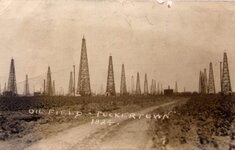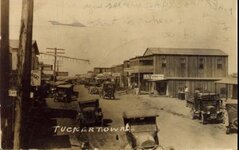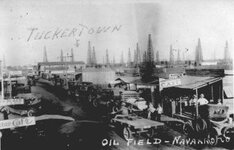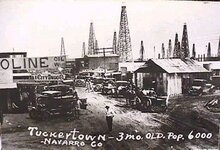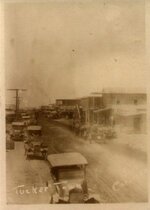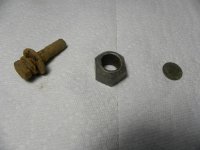Gypsy Heart
Gold Member
Prior to the oil boom, P. T. Fullwood had leased the McKie property in what was to become the northern part of the Powell Field, for ranching and farming operations. Fullwood had a small grocery store in the southern corner of the leased acreage. The town site was laid off around the grocery. The township was the creation of Fullwood and Tucker. "Tucker was a town site promoter who had helped develop new boom town in the Ranger and Eastland Fields."24 Tucker and Fullwood formed a partnership to develop the town.
Lots were quickly sold by Tucker and Fullwood and Tuckertown grew rapidly. Within two months the population had mushroomed to 3,000 and in another month Tuckertown was a little city of 6,000.25 The Corsicana Daily Sun stated:
"Never in the history of oil field development has any town sprung up into such a thriving little village as Tuckertown. Now less than four months old, Tuckertown has a daily population of 3,000. When oil operations came across Chambers Creek with Humphrey's McKie #1 and McKie #2 in June, a little soft drink and confectionery shack was built at the crossroads entrance to the McKie farm. Tuckertown got in the middle of the big pay. Business came from all sides of the big fields and made it one of the most prosperous oil field towns in the entire country."26
Tuckertown was located approximately six miles southeast of Corsicana. A gravel road ran south from Corsicana to Beaumont. This road is now U.S. Highway 287. The gravel road ran parallel to the Trinity-Brazos Valley Railroad which extended to the town of Navarro and beyond. Approximately four miles south of Corsicana, a road ran eastward from the southbound road from Corsicana. Tuckertown was located approximately four miles eastward on this road, which is not F/M #637.
It its day, Tuckertown exemplified for Navarro County the free-wheeling, high-pitched way of life that was the oil boom.
Powell, Mildred and Navarro, towns that had been small farming communities before the oil boom, grew with tremendous speed. The business expansion at Powell included a new brick bank building. The LaRue and Barton, wholesale grain and grocery concern, set up a new warehouse near the Cotton Belt RR tracks.27
Tuckertown followed the pattern of many boom towns. It grew rapidly in six months to a population of 6,000 and declined when drilling moved south westward. Tuckertown was laid out on each side of the road and was approximately one-half mile long. Alleys ran between some buildings to provide passageways to the rear areas. The buildings were both permanent and temporary. The were build of wood, sheetmetal, tar-paper, canvas and cardboard. Tents, shacks, showers and outdoor toilets were scattered behind the main row of buildings.
At the height of its population the town consisted of five grocery stores, three small hotels, two large hotels (of fifteen and forty rooms), a large clothing store, barber shops, bit and rig repair shops, cafes, sandwich shops and blacksmith shops.
Reported in the Corsicana Daily Sun, September 22, 1923, included "a boiler works, one filling station, a garage, a movie house, a machine shop, two drugstores, a dancehall, a shooting gallery, and a shoe and boot repair shop completed the makeup of Tuckertown. A few shacks and tents were located behind and at each end of the main road in Tuckertown. There were some homes of the married workers near the town.28
Lee Brashear, who worked in Dad's Grocery in Tuckertown, said of the town:
"Tuckertown was created in a very short time. It was a temporary town because of its rapid construction and because of the temporary existence of the field. In spite of this, Tuckertown served its purpose of residence and supply well enough to meet the basic needs of its residents."29
In October, 1923, a fire occurred in Tuckertown. It was thought to have been caused by a drunk smoker in a hotel and it burned most of the north side of Tuckertown, leaving a few scattered places on the east end. Most of the area burned was rebuilt. Four months later another fire on the north side of the street destroyed some structures. This time no rebuilding was done.
As time passed, drilling to the southwest end decreased production in the Powell Field caused the decline of Tuckertown.
This rosy picture was quickly changed when, on May 8, 1923 the J. K. Hughes-McKie #1, on the east bank of Chambers Creek, blew in as the first prime producer at 2,850 feet, spewing 8,000 barrels per day high over the crown block, located one mile and a quarter southeast of the discovery well. Tragedy struck in less than 24 hours after the McKie well came in. The men were attempting to cap the well and it was time to change shifts. Somehow a spark from a tool or rock ignited the flowing well and thirteen men were burned to death. Three of the men lived a few hours and died in the old P&S Hospital.
Hughes purchased a lot in Oakwood Cemetery and the remains of six of the men were buried there. According to Robert Cason, Hughes sent 13 wreaths, one for each man killed, to the cemetery.
It is the intention of the Navarro County Historical Society to have the remaining names of the men who were buried elsewhere put on the large monument, so that it will be a memorial to all 13 who lost their lives in that huge oil fire. This work will be done under the direction of Hubert Farmer and Central Monument Company.
The men who died that day were: Emmett Byrd, Travis Owen, L.C. Cook, M.O. Turner, S.P. Allen, W.A. Hicks, Jack Cooper, E.E. Cooper, Dan Phillips, James Phillips, Fred Craig, L.P. Sheek, and Charles Walker.
Each spring Corsicana celebrates an event called "Derrick Days". During this time the citizens relive the oil boom days when Corsicana could boast of being the "First Oil Field West of the Mississippi River". Stories of the early days are retold and enjoyed.
The Texas State Historical Marker to honor Tuckertown was made possible by donations from Bill and Ben McKie, R.L.. Wheelock Jr., C.L. Brown, H.R. Stroube Jr. and George Weinschel.
http://www.txgenweb6.org/txnavarro/towns/tuckertown/tuckertown_boom_town.htm
Lots were quickly sold by Tucker and Fullwood and Tuckertown grew rapidly. Within two months the population had mushroomed to 3,000 and in another month Tuckertown was a little city of 6,000.25 The Corsicana Daily Sun stated:
"Never in the history of oil field development has any town sprung up into such a thriving little village as Tuckertown. Now less than four months old, Tuckertown has a daily population of 3,000. When oil operations came across Chambers Creek with Humphrey's McKie #1 and McKie #2 in June, a little soft drink and confectionery shack was built at the crossroads entrance to the McKie farm. Tuckertown got in the middle of the big pay. Business came from all sides of the big fields and made it one of the most prosperous oil field towns in the entire country."26
Tuckertown was located approximately six miles southeast of Corsicana. A gravel road ran south from Corsicana to Beaumont. This road is now U.S. Highway 287. The gravel road ran parallel to the Trinity-Brazos Valley Railroad which extended to the town of Navarro and beyond. Approximately four miles south of Corsicana, a road ran eastward from the southbound road from Corsicana. Tuckertown was located approximately four miles eastward on this road, which is not F/M #637.
It its day, Tuckertown exemplified for Navarro County the free-wheeling, high-pitched way of life that was the oil boom.
Powell, Mildred and Navarro, towns that had been small farming communities before the oil boom, grew with tremendous speed. The business expansion at Powell included a new brick bank building. The LaRue and Barton, wholesale grain and grocery concern, set up a new warehouse near the Cotton Belt RR tracks.27
Tuckertown followed the pattern of many boom towns. It grew rapidly in six months to a population of 6,000 and declined when drilling moved south westward. Tuckertown was laid out on each side of the road and was approximately one-half mile long. Alleys ran between some buildings to provide passageways to the rear areas. The buildings were both permanent and temporary. The were build of wood, sheetmetal, tar-paper, canvas and cardboard. Tents, shacks, showers and outdoor toilets were scattered behind the main row of buildings.
At the height of its population the town consisted of five grocery stores, three small hotels, two large hotels (of fifteen and forty rooms), a large clothing store, barber shops, bit and rig repair shops, cafes, sandwich shops and blacksmith shops.
Reported in the Corsicana Daily Sun, September 22, 1923, included "a boiler works, one filling station, a garage, a movie house, a machine shop, two drugstores, a dancehall, a shooting gallery, and a shoe and boot repair shop completed the makeup of Tuckertown. A few shacks and tents were located behind and at each end of the main road in Tuckertown. There were some homes of the married workers near the town.28
Lee Brashear, who worked in Dad's Grocery in Tuckertown, said of the town:
"Tuckertown was created in a very short time. It was a temporary town because of its rapid construction and because of the temporary existence of the field. In spite of this, Tuckertown served its purpose of residence and supply well enough to meet the basic needs of its residents."29
In October, 1923, a fire occurred in Tuckertown. It was thought to have been caused by a drunk smoker in a hotel and it burned most of the north side of Tuckertown, leaving a few scattered places on the east end. Most of the area burned was rebuilt. Four months later another fire on the north side of the street destroyed some structures. This time no rebuilding was done.
As time passed, drilling to the southwest end decreased production in the Powell Field caused the decline of Tuckertown.
This rosy picture was quickly changed when, on May 8, 1923 the J. K. Hughes-McKie #1, on the east bank of Chambers Creek, blew in as the first prime producer at 2,850 feet, spewing 8,000 barrels per day high over the crown block, located one mile and a quarter southeast of the discovery well. Tragedy struck in less than 24 hours after the McKie well came in. The men were attempting to cap the well and it was time to change shifts. Somehow a spark from a tool or rock ignited the flowing well and thirteen men were burned to death. Three of the men lived a few hours and died in the old P&S Hospital.
Hughes purchased a lot in Oakwood Cemetery and the remains of six of the men were buried there. According to Robert Cason, Hughes sent 13 wreaths, one for each man killed, to the cemetery.
It is the intention of the Navarro County Historical Society to have the remaining names of the men who were buried elsewhere put on the large monument, so that it will be a memorial to all 13 who lost their lives in that huge oil fire. This work will be done under the direction of Hubert Farmer and Central Monument Company.
The men who died that day were: Emmett Byrd, Travis Owen, L.C. Cook, M.O. Turner, S.P. Allen, W.A. Hicks, Jack Cooper, E.E. Cooper, Dan Phillips, James Phillips, Fred Craig, L.P. Sheek, and Charles Walker.
Each spring Corsicana celebrates an event called "Derrick Days". During this time the citizens relive the oil boom days when Corsicana could boast of being the "First Oil Field West of the Mississippi River". Stories of the early days are retold and enjoyed.
The Texas State Historical Marker to honor Tuckertown was made possible by donations from Bill and Ben McKie, R.L.. Wheelock Jr., C.L. Brown, H.R. Stroube Jr. and George Weinschel.
http://www.txgenweb6.org/txnavarro/towns/tuckertown/tuckertown_boom_town.htm


